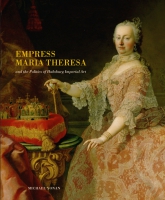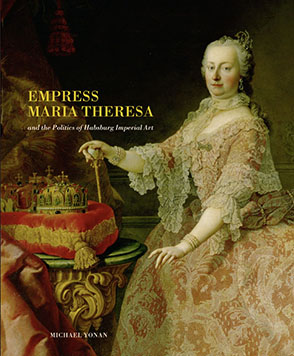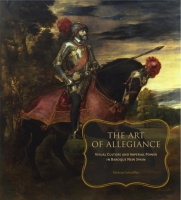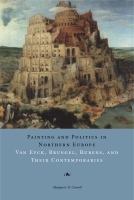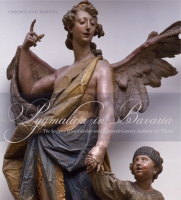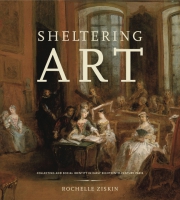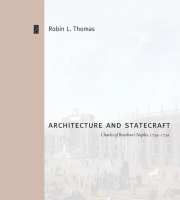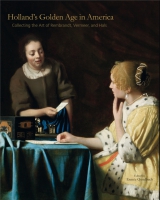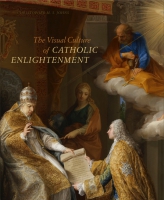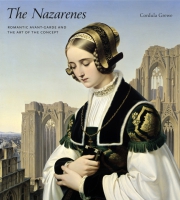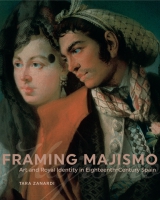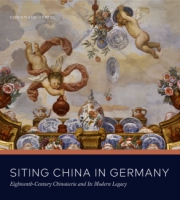Empress Maria Theresa and the Politics of Habsburg Imperial Art
Michael Yonan
“Michael Yonan’s Empress Maria Theresa and the Politics of Habsburg Imperial Art contributes significantly to scholarship on Maria Theresa and the Habsburg Empire in particular, and to eighteenth-century studies and art history in general. Yonan deftly explores a number of paintings and architectural spaces as points of departure for understanding the construction of Maria Theresa’s complicated and often conflicting imperial identity. He compellingly demonstrates the importance of visual and material culture in promulgating and communicating notions about gender and positions of power.”
- Description
- Reviews
- Bio
- Table of Contents
- Sample Chapters
- Subjects
Maria Theresa never obtained her power from men, but rather inherited it directly through birthright. In the art and architecture she commissioned, as well as the objects she incorporated into court life, she redefined visually the idea of a sovereign monarch to make strong claims for her divine right to rule and for hereditary continuity, but also allowed for flexibility among multiple and conflicting social roles. Through an examination of Maria Theresa’s patronage, Michael Yonan demonstrates how women, art, and power interrelated in an unusual historical situation in which power was legitimated in women’s terms.
“Michael Yonan’s Empress Maria Theresa and the Politics of Habsburg Imperial Art contributes significantly to scholarship on Maria Theresa and the Habsburg Empire in particular, and to eighteenth-century studies and art history in general. Yonan deftly explores a number of paintings and architectural spaces as points of departure for understanding the construction of Maria Theresa’s complicated and often conflicting imperial identity. He compellingly demonstrates the importance of visual and material culture in promulgating and communicating notions about gender and positions of power.”
“Michael Yonan's Empress Maria Theresa and the Politics of Habsburg Imperial Art illuminates not only the complexities of Habsburg patronage and politics but also the particular challenges faced by a female ruler. The author's astute analyses of royal portraits, palace architecture, decoration, and garden design, together with insightful interpretations of the exotic, literary, and classical iconography of her commissions, reveal how Maria Theresa shaped her complex, multidimensional identity as a powerful sovereign, mother, wife, and widow. This engaging and beautifully illustrated volume is an essential source for all future studies of the Habsburg empress and an outstanding contribution to our understanding of eighteenth-century monarchs, visual culture, and gender.”
“This is a most welcome study of Viennese imperial cultural politics under the exceptional reign of Empress Maria Theresa (1717–80), who for the longest time has been underestimated in almost every respect: as ruler, as art patron, and as an individual who used her intellectual and intuitive acuity to analyze and shape the gendered cultural politics of her day. Yonan addresses each of these areas, interweaving them with his account of Schönbrunn Palace, its art and architecture, interior decoration, and park. His central focus on this palace and the empress as its author offers a refreshing and convincing alternative model to the traditional one-sided, if indisputable, image of Maria Theresa as a supreme strategist in the art of marriage politics who placed her numerous offspring in the royal and electoral courts of Europe.
“Yonan’s superbly illustrated book is the first to examine the full and astounding range of Maria Theresa’s patronage of all the courtly arts of her day as a complex, subtle, and effective means of representing her rulership. The palace’s interior structure and decorations, while maintaining the link to ancient Rome, are cognizant of the Austro-Hungarian crown lands’ multiethnicity, mythologize the Habsburg Empire’s historically contentious relationship with the Ottoman Empire, and orientalize the empires of the Far East. In all of these undertakings—the decoupaged Mughal paintings of the Millionen-Zimmer, the Vieux-Laque Zimmer’s chinoiserie framing Pompeo Batoni’s Roman portraits of Emperor Franz Stephan and their sons, the park’s allusions to sybilline wisdom and mourning, and the preservation of Franz Stephan’s palatial spaces—Maria Theresa, ostensibly the devoted sovereign widow and mother, never challenging masculine dynastic succession, forged a calculated amalgamation of intimacy and authority, private withdrawal and public display, Orient and Rome, into a powerful imperial identity entirely her own. This identity, subtly diffused throughout Schönbrunn’s imperial art, is also carefully charted and controlled in the state portraits of Maria Theresa as queen of Hungary, imperial spouse, mother, widow, art lover, and in oriental costume, yet never primarily as empress.”
“Michael Yonan’s Empress Maria Theresa and the Politics of Habsburg Imperial Art is a groundbreaking study of the political semantics surrounding Maria Theresa’s patronage of the visual and applied arts. Yonan effectively harnesses the empress’s image in paintings and the decorative arts, its spatialization in interior architecture, and its naturalization in gardens to reveal the complex, often overlapping roles of sovereign, empress, mother, and widow in Theresian imagery.
“Yonan writes with a keen eye for visual description throughout the book’s lavishly illustrated chapters. Empress Maria Theresa remains a highly original, important work cutting across art history, cultural history, and gender studies. Yonan’s analytical framework of ‘monarchical image’ will stimulate further discussion not only within the field of Habsburg and Austrian studies but also among those interested in the semantics of power more broadly.”
“Engagingly written and cogently argued, Michael Yonan’s book will become a model for those scholars seeking to go beyond traditional patronage studies to achieve a more sophisticated understanding of the role of art and visual culture in defining European monarchy during the Old Regime.”
“This is the most fascinating book published about Maria Theresa in a long, long time. It should certainly be read by anyone interested in Vienna, the Habsburgs, or, more generally, the relation of art and politics in the eighteenth century. Michael Yonan is an immensely stimulating historian and art historian of Central Europe.”
“Yonan . . . [provides] important examinations of [a] hitherto overlooked [monarch], especially in English language scholarship. [His] indexed and beautifully illustrated [volume includes] detailed annotations of [his] archival resources, which allows future scholars to bring the visual culture of Empress Maria Theresa . . . into greater conversation with parallel artistic activity. Yonan’s . . . success in linking the patronage of [this empress] to the political and artistic currents of [her age] demonstrates the folly in divorcing such figures from our study of avant-garde artwork in early modern and modern eras. For though absolutism was increasingly retrograde by the lifetime of Maria Theresa . . . , our understanding of social art history and particularly female portraiture is incomplete without a consideration of [such] monarchs and their peers among the European aristocratic elite.”
“Thanks to Yonan’s interpretive approach, Empress Maria Theresa and the Politics of Habsburg Imperial Art is a ground-breaking study in the history of Austrian art and architecture. His book is a substantial contribution to the study of women as powerful agents in the production and reception of visual culture in European court circles during the eighteenth century.”
Michael Yonan is Associate Professor of Art History at the University of Missouri–Columbia.
Contents
List of Illustrations
Acknowledgments
Introduction
1. The Empress’s Image
2. The Widow’s Gift
3. Spaces of Intimacy and Authority
4. The Vieux-Laque Zimmer
5. Scheherazade and the Sultan’s Mother
6. Egeria’s Spring
Conclusion
Notes
Bibliography
Index
Introduction
To a social order defined in masculine terms, a powerful woman offers both fascinating promise and a troubling conundrum. Governmental power and femininity contradict each other in western culture’s dominant formulations of rule, which for centuries accepted female heads of state as uncomfortable concessions to a patriarchal social order and therefore fraught with inconsistencies and dangers. To many, female monarchs fundamentally lacked the skills required for successful leadership, and precisely due to their sex. This of course did not mean that women never held power, even substantial power, in the European tradition; the continent’s history is filled with examples of prominent queens, and indeed, in the cases of Elizabeth I of England and Catherine the Great of Russia, the woman ruler could valorize the best traits of the nation she governed, even become a symbol of its greatest achievements. Women not granted royal status directly could also yield power within the complex social structures of European aristocratic culture, and European history abounds with examples of female courtiers and noblewomen whose status permitted them substantial influence in state affairs. Yet the prominence of specific women never changed the basic patriarchal character of western political culture, and in nearly every case one could document, skeptics accused the powerful female of transgressing the rightful boundaries of her sex.
Given the tenacity of such ideas in western political culture, some readers might be surprised to find writers promoting female rule, going against the tide, as it were, to suggest not only that women can rule, but in fact should. One example is the extended justification of women in power propounded by the baron de Montesquieu in his formative political treatise L’esprit des lois (1748). Montesquieu claimed that nothing inherently prevented women from governing successfully. Women are in fact better suited to government than to running a household, Montesquieu noted, since by leading a family a woman goes against reason and nature, the two predominant normalizing concepts of his Enlightenment mentality. Yet in affairs of state, women thrive and excel because the feminine constitution grants them exactly the qualities necessary for good government. Women’s weaker bodies render them gentle and moderate, while their bodies likewise oppose them to the bellicosity and brute strength associated with the masculine king. Their softer flesh, however, requires female monarchs to consult knowledgeable advisors and counselors to help “carry the weight of government,” as the French philosopher put it. Women can rule, he says, but can never overcome the fundamental weakness of their sex, and power, when entrusted to a woman, requires delegation among many in order to bolster its strength. Underlying this observation is an odd overlapping between physical strength and sound judgment.
It is worth taking a moment to delve into Montesquieu’s ideas a little more deeply, since its implications for associating women with political power are substantial. To support his claims, Montesquieu provides a list of societies that women led successfully. In the Indies and in Africa, he writes, women traditionally governed when there was no available male, and these lands have thrived in an Edenic innocence far removed from European degeneracy. In Europe he finds only two nations that have prospered under female rule: England and Russia. Montesquieu mentions these lands in order to critique his native France, which had stringently barred women from monarchical governance through the institution of Salic law, a medieval concept expressly forbidding women from independently assuming the French throne. By showing his readers how women fostered good government both within Europe and afar, as well as by listing the social benefits it produced, Montesquieu highlights the folly of masculine dynasticism, which brought to power individuals who met only the criterion of primogeniture and may otherwise have lacked any other characteristics required for good government. The critique of French monarchy implicit in L’esprit des lois therefore is drawn along gendered lines; women might be weak of body, says Montesquieu, but they make better rulers than unmotivated or despotically inclined firstborn males.
Given Montesquieu’s attention to his arguments’ contemporary viability, and the dynamics of femininity and power he explores, it might seem curious that he omits a woman monarch who ruled an empire in the 1740s, exactly the moment when he readied his treatise for publication. That would be Empress Maria Theresa (1717–1780), hereditary successor to a long line of Holy Roman Emperors, sovereign ruler of the vast Habsburg territories, queen of Bohemia and Hungary, and archduchess of Austria, to name just the most prominent of her many titles. Given her political prominence and the sheer expanse of Habsburg dominions in the middle eighteenth century, her absence from Montesquieu’s discussion is notable, and reveals the philosopher’s attitude toward her status and potential longevity. Montesquieu’s interest apparently is not in all ruling women, but specifically in those nations whose governmental systems permitted female rule by law as a permanent part of their governmental structure. In that sense, Maria Theresa perhaps presented a problem: she ruled, authorized by lineage and justified by imperial decree, but she still represented an unusual case within the exclusively male domain of Habsburg monarchical tradition. Indeed, Maria Theresa was the first and only sovereign female ruler in Habsburg history, and despite her claims to power, her rule did not allow for the Habsburg throne’s fundamental masculinity to be challenged. Recognizing that, Montesquieu may have viewed her simply as an aberration, and, given her youth and lack of preparation to govern at the time of her accession, someone not likely to rule for long.
In fact, Maria Theresa’s reign from 1740 to 1780 was enormously successful by Habsburg standards, and during it the empire underwent a series of administrative reforms, political consolidations, and cultural developments that not only laid the groundwork for the development of multiple modern European states, but also enabled Austria to claim for itself a golden age comparable to the Elizabethan or Catherinian ones. Under her rule, the Habsburg Empire enjoyed significant international political influence, even as her policies instigated internal reorganizations of education, medicine, and civic administration. These activities revitalized or modernized territories far beyond Austria’s modern borders, ranging from Belgium to Ukraine and from Tuscany to Poland. Maria Theresa involved herself directly in these reforms, and given the empire’s later political troubles leading to its dissolution in 1806, she has become for Austria the prototypical great monarch during whose reign the national character’s best qualities flourished through territorial expansion and cultural influence. The critical literature on Austrian history has styled her as the Landesmutter, the mother of her people, and her reign has been subject to intense mythologization and glorification. Innumerable popular biographies and children’s picture books have canonized her, and her entire era has been sentimentalized into delicious pastiche, most seductively in Hugo von Hofmannsthal’s libretto to Richard Strauss’s opera Der Rosenkavalier.
My engagement with Maria Theresa originated out of a fascination with how contemporary Austrian culture treats her, as well as through my recognition of the contradictions for women in power that Montesquieu explored and that persist in modified ways today. As I investigated Maria Theresa’s story, however, I found a more important and less clearly acknowledged one: the story of how a female monarch actually ruled, how her power was justified, manipulated, and understood, and the role that culture, particularly visual and material culture, played in representing ideas about her power to her subjects, her court, her family, and herself. That history lies at the heart of this book, which examines the formulation of Maria Theresa’s monarchical power in paintings, its spatialization in architecture, its naturalization in gardens, and its description in writings. My point, ultimately, is that being an empress did not permit total autonomy in decisions of self-representation, and that in some respects Maria Theresa demonstrates how monarchical power and femininity remained at odds in eighteenth-century political discourse even as writers like Montesquieu could imagine their coalescence. This situation might seem ironic for an age in which women ruled large territories of the European continent and when women’s influence in social developments reached an apex.
My hope is that this study will achieve something even bigger: namely to encourage a rethinking of monarchical imagery more broadly and an elaboration of the theoretical perspectives commonly brought to it. Maria Theresa’s power is particularly interesting to conceptualize since she ruled as a sovereign, a native of one of the countries she governed and the hereditary inheritor of her family’s titles. She was not a monarch by marriage, as were most early modern queens, nor a royal consort like Madame de Pompadour, nor a regent on the throne only until her successor’s maturity. Sovereignty accorded Maria Theresa a symbolic position to monarchical power distinct from that occupied by her female contemporaries; it also lent Maria Theresa’s imperial iconography special urgency in that it was required to emphasize her rule as rightful and divinely ordained. Noting this difference is crucial, particularly when one recognizes the degree to which scholarship on early modern queenship has defined its limits and boundaries by analyzing women who held no official autonomous political power. Marie de’ Medici and Marie Antoinette, to name two of the most frequently discussed, were at a remove from authorized monarchical authority since they married into queenship.
Understanding Maria Theresa’s situation requires us to frame our approach to femininity and monarchy differently. As a hereditary ruler, Maria Theresa sought to emphasize her relationship to both male and female predecessors in order to stress the continuity of her dynasty. In this sense she resembles England’s Elizabeth, but unlike Elizabeth, Maria Theresa ruled at a moment when discourses defining women’s social roles, the family, and government in general were undergoing rapid philosophical and social reassessment. The Enlightenment placed new pressures on women, monarchical women included, to defend their actions in the public sphere and account for their usefulness to society. Emphasizing Maria Theresa’s role as mother, wife, and widow therefore became paramount in her iconography, a fact that distinguishes her strikingly from Elizabeth’s self-promotion as the Virgin Queen. Tracing sovereignty’s influence on Maria Theresa’s art will be a major theme of this book, but I shall also show how power did not exempt Maria Theresa from pressures and limits well known to women of other social strata. Indeed, part of the empress’s brilliance as a monarch derived from her ability to recognize the strategic value of traditional femininity, the ways in which widespread conceptions of womanhood could feed into and support her exceptional monarchical situation. Female power required a new vocabulary to make its presence palpable, to diffuse its threatening difference, and the visual arts became a way for Maria Theresa to blend sovereignty and femininity into a convincing whole.
It was predominantly through her body that the empress formulated this imperial identity. Even when not represented pictorially in a work of art, the imperial body recurs time and again as a central concern of Maria Theresa’s visual and material culture, be it her body’s physical situation within architecture, its symbolic presence in room decoration, or the guises it assumed in images. Certainly Montesquieu understood the monarch’s body, male or female, as essential to their power and the social health of their governed lands. Ever since Ernst Kantorowicz postulated that European monarchs possessed two bodies, one natural and one political, scholars have striven to understand the complexities of monarchical culture and imagery in corporeal terms. Although the monarch might have a physical body, his body natural, subject to decay and death, he also possessed a body politic, a body of state that was everlasting, public, and inviolate. This distinction allowed for the king to remain a permanent, immutable aspect of political culture even as individual monarchs changed and grew old. For Kantorowicz this process held deeply Christian underpinnings traceable to medieval theology. The notion of the king’s two bodies rendered such contradictory statements as “Le roi est mort, vive le roi!” symbolically logical within monarchical philosophy. The king’s body therefore sits at a nexus of concepts about identity, subjectivity, the state, and the populace, and defining the nature and limits of the monarchical body could be understood as the ultimate goal of a wide range of monarchical ceremonies, images, textual descriptions, and discursive practices.
But what of female monarchs like queens and empresses? My study takes as a starting point that queenship was fundamentally distinct from kingship and that female monarchs like Maria Theresa occupied social positions fraught with issues inflected at all levels by their sex. This is not to say that gender was the only aspect of their identities that carried weight. Far from it; but it does appear that gender held special significance. In assuming this stance, I follow in the footsteps of scholars who have recognized that Kantorowicz’s two-body model proves insufficient for understanding the complexity of the queen’s body. One prominent voice in this rethinking has been Lynn Hunt, who has argued in her study of Marie Antoinette that the French queen had many bodies, that it was a site of threat or disruption to the body politic precisely because it could assume a wide array of meanings. Although I shall show how Maria Theresa’s body likewise can be conceived as multiple and diverse, I challenge the idea that diversification rendered it inherently threatening to political culture, and will argue in fact that Maria Theresa’s diverse bodies were potentially valuable to an imperial conception of rule. Important to my thinking has been Abby Zanger’s scholarship on Louis XIV and his bride María Teresa of Spain. Zanger has argued against Kantorowicz’s privileging of the body politic over the body natural, which she demonstrates was just as important for absolutist statehood. Royal weddings, to Zanger, illustrate this clearly since they celebrated the physical union of bodies that would produce the heir required for dynastic succession. The queen’s body in this sense is not a site of corruption to the body politic, but rather an essential component of it, one whose physicality demanded glorification. Zanger’s ideas have direct applicability to Empress Maria Theresa, since fertility formed a central aspect of Habsburg dynastic lore, celebrated in numerous images and writings. Zanger helps us assess statements like Maria Theresa’s oft-reprinted comment that “I never tire of having children,” as well as the obvious fact of her sixteen pregnancies, less as outgrowths of a protobourgeois domesticity or a love of motherhood than as a form of female political enhancement.
The most recent thinking on early modern queens has followed Zanger’s lead and reasserted the importance of physical bodies as sites of appropriation and empowerment. In particular, work by Rachel Weil and Louis Montrose has emphasized how both physical and representational bodies of queens could be harnessed to enhance the monarch’s authority, while Jennifer Germann has charted how the placement of the queen’s body in imagery, or for that matter its absence, illuminates her importance. The following analysis parallels closely this newer scholarship. That said, I do not wish to idealize the past as a space of perfect female agency, a trap into which some revisionist writing about queens has fallen. Analyzing “self-fashioning” can slip uncomfortably into a celebratory discourse whereby commissioning art becomes a process of triumphant self-actualization. My study shows that there were limits to the body’s efficacy as a site of power in eighteenth-century Europe, and indeed circumventing the monarchical body was sometimes as much the goal as reasserting its primacy, as Germann also notes. For all its possibilities, the empress’s body remained as much a site of confusion and instability as authority, and the art made around her often reads as imperfect solutions to complex social and political demands.
To highlight that instability, I employ the term “monarchical identity” to describe a fictive image of the ruler, a construction not necessarily reducible to a single textual reference or painting, but a collective ideological tissue born of various statements, legends, actions, and representations. Whether such stories are “true” or whether eighteenth-century subjects believed in them is less important than their simple existence. Narrative undergirds monarchical identity, since the stories that hovered around monarchs formed important elements in how power flourished and were in fact constitutive elements of that power. They were the raw material out of which political power became real in a world where monarchs retained divine elements. Monarchical identity overlaps somewhat with Kantorowicz’s body politic, but is centered more on the monarch’s individual person than on his or her collective self, which is as much determined by the people he or she governs as the monarchs themselves.
By delineating closely Maria Theresa’s monarchical identities—the stories told about her, the concepts she engaged in her art, and the myths she herself promoted—I think we can approach a better understanding of how power was created and naturalized on a single royal body. The following chapters therefore examine the diverse narratives of rule employed to form Maria Theresa’s multiple monarchical identities. Some strategies are purely pictorial or spatial in character, while others have analogues in the literary genres of the fable, the chronicle, and the epic. Perhaps that narratival aspect of power was more critical to eighteenth-century absolutism than ever before, since during this period monarchy itself underwent thorough reconceptualization. It is not an exaggeration to say that in a time of such fundamental change, every king and queen needed to redefine his or her monarchical status repeatedly and anew. When history renders seemingly immutable truths insecure, stories proliferate about the value and anatomy of those truths, and from these one can mine complex veins of historical meaning.
This book shows that Maria Theresa’s monarchical identity was by necessity a fragmented one that resulted from the unusual, unprecedented status of her rule. Even if being an empress did not grant total power to represent oneself as one wished, Maria Theresa still emerges in these pages as an active shaper of her monarchical identity, although that shaping is subtler and more indirect than what one might expect from a reigning sovereign. If the queen’s body proves so critical for understanding queenship in the early modern period, so does the way that body appears in representation, and this study is principally an inquiry into royal representation defined at its broadest. In addressing this, I follow in the footsteps of those that have scrutinized the functioning of the monarchical image, central among them Peter Burke, whose The Fabrication of Louis XIV charts representations of Louis across his long reign. It is a sort of encyclopedia of Louis’ image in all of its permutations and allows that image to be seen, crucially I think, as a form of communication. That facet of Burke’s argument he bases on Erving Goffman’s Presentation of the Self in Everyday Life, the classic sociological study that discusses the human body as a conveyor of meanings in social space. Burke formulates the image as message, which allows him to examine art in terms not just of its maker, but also of its patron and its viewers. He defines the royal image as being about celebrating Louis, for the most part, and working ideologically within his political strategies and programs.
My belief that royal imagery is about conveying something derives directly from Burke, but my interests are at once more limited and broader than his. On the one hand, I am less concerned with the image per se than with visual and material culture more expansively: a work of art, a garden layout, or a decorated room need not include a picture of the empress in order to say something about her, and indeed these sorts of nonrepresentational and nonreferential constructions may have been precisely the places where the most interesting possibilities for meaning existed. I argue in particular that messages can be conveyed via diverse visual cues, and that eighteenth-century monarchs like Maria Theresa were aware of and manipulated those possibilities. This study therefore explores a much wider range of cultural products than Burke’s, including not just portraiture but also interior decoration, palatial space, and garden design, in order to track those places and moments where Maria Theresa could be figured as a powerful female ruler. In this respect mine is more akin to the approach of Louis Marin, who finds monarchical power in a wide range of material and cultural products.
Moreover, although I derive inspiration from Burke’s notion of art as communication, the following argument is less wedded to the idea of the image as a message. Rather, I argue that we can understand a visual construction as a kind of definition, a conglomeration of ideas entered into the social sphere in order to explain the nature of imperial power. It needn’t be read or interpreted by anyone in order to contain a kernel of cultural meaning, but its existence alone reveals an attempt to alter or recategorize impressions of power. In other words, I see the work of art as an intervention into social semantics and, therefore, as a moment when meanings about monarchy can be manipulated. This is an especially important point to make with respect to Maria Theresa, since as a female monarch she encountered special challenges in formulating a language of powerful self-representation. The tradition for showing female monarchs as sovereign rulers was sketchy at best and had no precedence at all in the Habsburg tradition. Female monarchical power is necessarily expressed more subtly. If Louis’ images are statements about his monarchical glory, then Maria Theresa’s are sometimes less proclamations than whispers.
The following also contributes to understanding a historical figure who deserves to be better known in the English-speaking world and who remains understudied relative to her historical importance. Even in German-language scholarship, attention to Maria Theresa is surprisingly intermittent and incomplete. Alfred von Arneth’s magisterial multivolume chronicle of her reign, produced in the middle nineteenth century, persists in being the most commonly referenced source on her life. Perhaps due to its exhaustiveness and length, Arneth’s study has dissuaded subsequent scholars from approaching Maria Theresa, with the result that most newer writing on her has been popular rather than scholarly. There exists little writing that tries to recategorize her achievements and rethink her importance to our knowledge of early modern monarchy, a major lacuna that Rita Krueger’s scholarship will surely help redress. Particularly puzzling has been the lack of interest in her among scholars of women’s history and art history; there is no English-language study that examines Maria Theresa from a feminist perspective, nor one that seeks to integrate her into larger scholarly projects devoted to understanding representations of women or the history of female agency. This absence is astonishing given that Maria Theresa’s contemporaries discussed her precisely as a gendered political phenomenon and a major contender in the international politics of the Old Regime. Perhaps her acknowledged social conservatism stands in the way of a feminist reclamation; wedded to traditional Catholicism, continuously pregnant, and at least ostensibly uninspired by Enlightenment revelations, Maria Theresa might appear an unlikely role model for rethinking gender. But she is a more complex figure than she first appears, a point noted by a handful of recent scholars who have sought to apply a gender studies perspective to her, Ilsebill Barta and Regina Schulte central among them. Following their lead, I ask how we might reclaim this historical figure for the history of women, and furthermore how her art might illuminate the intersections between gender and monarchical culture.
To achieve these ends, I have not attempted to survey Maria Theresa’s art patronage in its entirety, nor do I catalogue the art and architecture she commissioned comprehensively. This book likewise is not a building history of Schönbrunn Palace nor really a patronage study at all. Rather, I have been deliberately selective, singling out a handful of noteworthy paintings, architectural settings, and objects in order to unravel in detail the ways in which Maria Theresa’s monarchical identity can be located in them. My inquiry begins with an analysis of the empress’s image in portraiture, which I approach from the standpoint of identifying her various monarchical identities as formulated at different moments in her career. In doing this, I emphasize those aspects of her official imagery that stress her uniqueness, in order to unbind the strands that linked her right to rule, notions of Habsburg femininity, and female sovereignty in Enlightenment Europe. Two representations emerge as central to this discussion: Martin van Meytens’s State Portrait of Empress Maria Theresa (ca. 1750) and Anton von Maron’s Portrait of Empress Maria Theresa as a Widow (1773), which I identify as conflicting attempts to articulate female monarchical power visually and which form the centerpieces of chapters 1 and 2. I interpret the former as a combination of traditional Habsburg monarchical iconography with aspects of ideal femininity; the latter I see as a modification of that iconography to acknowledge her widowed status.
Chapter 3 turns to architecture in order to examine the room arrangement and decoration of the imperial suite at Schönbrunn. An analysis of her rooms there shows how the different political situations in which the empress found herself resulted in alternative configurations of palatial space. The strategic location of her body within architecture permitted her to maximize, or obviate, its social meanings. From there I turn to an extended analysis of a centrally important room in this suite, the Vieux-Laque Zimmer, named for its panels of black Asian lacquered wood, beside which hang family portraits by Maron and Pompeo Batoni. Chapter 4 begins by analyzing one portrait in detail, Batoni’s justly celebrated Portrait of the Holy Roman Emperor Joseph II and Grand Duke Leopold of Tuscany in Rome (1769), to demonstrate how it assumed new, unexpected significance when placed in this architectural setting. I also relate this room to the empress’s promotion of an Austrian arts industry, as well as notions of Vienna’s relationship to Rome and to other major European cultures, particularly the French. The room ties together a complex web of meanings positioned in a rococo tension whose subtlety and multivalency nuanced, I shall argue, the meanings it generated for the palace’s visitors.
Chapter 5 turns to another of Schönbrunn’s rooms, and arguably its most visually dazzling: the Millionen-Zimmer (Millions Room), an audience chamber in the empress’s apartments decorated with precious imported rosewood paneling, gold rococo boiserie, and a series of complexly arranged collaged Mughal paintings. This room is often regarded as the jewel among Schönbrunn’s interiors, its beauty widely admired, but the complex relationship between what it contains and its imperial inhabitant remains underexplored. My reading of the room imagines how both the subjects of Mughal painting and the techniques used in its construction served both to associate the Habsburgs with and distance themselves from a mythical Asia. The room’s decoration emerges as an aesthetic choice with political overtones that highlight the role of a woman in the imaginary travel it invites. My final chapter turns to an exterior space, Schönbrunn’s garden, to examine how Maria Theresa’s renovations to it not only made visible the mythical dynastic meanings associated with the palace, but once again postulated a woman’s place in that myth through sculpture. Here epic history and garden design combine in a single site, and the empress’s actual and representational selves could dialogue constructively.
Since much of my discussion hinges upon the renovations that Maria Theresa prompted at Schönbrunn, a certain amount of my argument rests on reconstructing how the palace’s interior and exterior artistic programs were assembled. This task would be easier were the documentary record for Schönbrunn under Maria Theresa more complete, but the written and visual sources for her activities there are frustratingly patchy, particularly when compared to the nearly endless record of royal patronage at other prominent European courts. Much of Schönbrunn’s interior was commissioned from artists on the court payrolls, which means that they often have left little or no paper trail outside of standard periodic payments. Likewise, the monarchs tended to subsidize official commissions with additional funds from their private coffers, the records for which are harder to trace. The administrative chaos that the Hofbauamt or court building office found itself in during Maria Theresa’s reign, which I discuss in chapter 3, did not help matters. The situation with visual sources is yet hazier. In 1773 the court architect Nikolaus Pacassi complained to Maria Theresa that the Hofbauamt needed to better catalogue and store its sizable collection of architectural plans. He requested from her a yearly stipend to form an archive specifically for this purpose because, he claimed, the court’s drawing collection was in total disarray and important images impossible to find. Alas, they have remained hard to find, since Pacassi’s archive has not survived and we therefore have just a handful of original plans and drawings to aid our understanding of Schönbrunn’s building history.
A significant source of information, however, is correspondence, be it from the empress’s hand, letters to her by various officials and diplomats, or those written from her courtiers and family members to each other. These often provide critical details about important works of art and about Schönbrunn’s overall appearance, as well as reveal significant artistic issues under discussion. Another extremely rich source is the fascinating diary of the court chancellor Johann Joseph Khevenhüller-Metsch (1706–1776). Kept meticulously for over three decades, it records abundant information on the court’s daily activities, usually centered on the monarchs themselves. With these at hand, I have tried to assess the documentary history of the palace as much as possible in the pages that follow, but recognize that for my specific interests the documents will never tell the full story. Only very infrequently does gender receive specific mention in these sources, yet the works of art themselves often engage with gendered concerns in manifold ways.
Part of my project is to show how art at Maria Theresa’s Schönbrunn resonates with larger cultural tendencies that link the Viennese context to those from across the continent. Readers will notice that I have particularly sought out connections to French culture. This is not just because Maria Theresa’s husband, Francis Stephen, as onetime duke of Lorraine brought with him to Vienna an approach to art common among francophone elites, but because so much of Viennese court art in this period was produced by expatriate French-speaking artists and architects. The empress’s closest confidant and the architect of her foreign policy, Prince Wenzel Anton von Kaunitz-Rietberg (1711–1794), served as the Viennese ambassador to Versailles from 1750 to 1753 and returned to central Europe an ardent Francophile, especially in the areas of court administration and artistic patronage, which he sought to reform after the Bourbon model. This emphasis on French influences may surprise readers who are accustomed to thinking of the “Austrian Baroque” as heavily Italianate in character. In all of this, I have tried to clear a path between documentary and imaginative histories, perhaps at the risk of fully achieving neither, in order to maximize the interpretative potential of the art under discussion.
The greatest danger of a study like this lies in the problem of intention. Whenever I can document Maria Theresa’s direct input into a work of art or architecture, I have incorporated it into my discussion. Such moments are infrequent, however, and in some respects peripheral to the point this book ultimately tries to make. Maria Theresa may not always have been directly behind the visual and spatial choices I examine, but all of the art I discuss bore a symbolic relationship to her. The patron’s intention was often assumed in royal commissions even when the monarch had little to do with its genesis. The European elite routinely interpreted royal imagery and buildings as statements about the monarch’s goals, politics, and influence, even when advisors formulated the art in question and when it presented internal contradictions and equivocations. My focus is less Maria Theresa’s actual control of art than the way art she commissioned could be read as monarchical statements about her. I therefore freely and unapologetically speculate on how art constituted the empress’s image and how it may have spoken to and for her in a variety of ways. It is only through this process, I believe, that we can parse out fully the possibilities inherent in this specific personage’s complex and multifaceted monarchical identities.
Mailing List
Subscribe to our mailing list and be notified about new titles, journals and catalogs.
